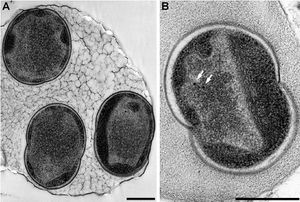Candidatus Scalindua
Classification
Domain: Bacteria
Phylum: Planctomycetes
Class: Planctomycetacia
Order: Planctomycetales Family: Brocadiaceae
Genus: Scalindua
Species: Candidatus Scalindua
Description
Anaerobic ammonium-oxidizing (anammox) bacteria use ammonium and nitrite and produce dinitrogen gas under anoxic Conditions.[1] This anammox reation is also a new short-cut process in nitrogen cycle. The “Candidatus Scalindua” group is primarily found in marine environments. It contains taxonomically diverse members, while only a few them have been successfully grown in enrichment cultures.[2] The Physiological characteristics of Candidatus Scalindua affiliated to Anaerobic ammonium-oxidizing (anammox) bacteria have been demonstrated only partially compared with the other anammox bacteria which can be found in fresh water.[3,4]
Ecology and Significance
Ca. Scalindua sp. can grow optimally in a pH range of 6.0-8.5 and in a temperature range of 10-30 oC. The Growth salinity (%) or level of salinity (mmol) is range of 1.5-4.0. It can tolerance 7.5(mM) Nitrite and 16(mM) Ammonium in the environment.[4-6] This microorganism is a halophilic bacteriua and it has higher affinity for nitrite and a lower growth rate than the other known anammox bacteria. It can also tolerance low temperature and maintain the anammox activity. These physiological characteristics can explain why the “Candidatus Scalindua sp.” can have advantage in marine sediments.[2]
Genome Structure
All currently marine anammox bacteria found in marine water columns and sediments worldwide belong almost exclusively to the ‘Candidatus Scalindua’ species. Researchers applied community sequencing of a marine anammox enrichment culture dominated by ‘Candidatus Scalindua profunda’ to construct a genome assembly, And analyse the most abundant gene transcripts and proteins.[7]
For NCBI GenBank entry for Candidatus Scalindua brodae → http://www.ncbi.nlm.nih.gov/genome/?term=Candidatus+Scalindua
Metabolism
Among anammox bacteria which include Candidatus Scalindua, they can reduction nitrite to nitric oxide by a cd1 nitrite reductase (NirS), condensation of ammonium and nitric oxide into hydrazine by a hydrazine synthase (HZS), and oxidation of hydrazine into dinitrogen gas by a hydrazine oxidoreductase.[7] It happen inside the ammoxosome, yields and requires two toxic intermediates, hydroxylamine and hydrazine. The reaction is :NH4+ + NO2- → N2 + 2H2O
Anammoxosome is the largest compartment of the anammox cell and is proposed to be dedicated to energy conservation.[8] Researchers also do the study related with anammoxsome.
References
[1]Hu Z1, Lotti T, de Kreuk M, Kleerebezem R, van Loosdrecht M, Kruit J, Jetten MS, Kartal B. Nitrogen removal by a nitritation-anammox bioreactor at low temperature.
[2]Takanori Awataa, Mamoru Oshikib, Tomonori Kindaichia, Noriatsu Ozakia, Akiyoshi Ohashia and Satoshi Okabeb Physiological Characterization of an Anaerobic Ammonium-Oxidizing Bacterium Belonging to the “Candidatus Scalindua” Group
[3]Nakajima J, Sakka M, Kimura T, Furukawa K, Sakka K. 2008. Enrichment of anammox bacteria from marine environment for the construction of a bioremediation reactor. Appl. Microbiol. Biotechnol. 77:1159–1166.
[4]van de Vossenberg J, Rattray JE, Geerts W, Kartal B, van Niftrik L, van Donselaar EG, Damsté JSS, Strous M, Jetten MSM. 2008. Enrichment and characterization of marine anammox bacteria associated with global nitrogen gas production. Environ. Microbiol. 10:3120–3129.
[5]van de Vossenberg J, Woebken D, Maalcke WJ, Wessels HJCT, Dutilh BE, Kartal B, Janssen-Megens EM, Roeselers G, Yan J, Speth D, Gloerich J, Geerts W, van der Biezen E, Pluk W, Francoijs KJ, Russ L, Lam P, Malfatti SA, Tringe SG, Haaijer SCM, Op den Camp HJM, Stunnenberg HG, Amann R, Kuypers MMM, Jetten MSM. 9 May 2012. The metagenome of the marine anammox bacterium ‘Candidatus Scalindua profunda’ illustrates the versatility of this globally important nitrogen
[6]Strous M, Heijnen JJ, Kuenen JG, Jetten MSM. 1998. The sequencing batch reactor as a powerful tool for the study of slowly growing anaerobic ammonium-oxidizing microorganisms. Appl. Microbiol. Biotechnol. 50:589–596.
[7]Jack van de Vossenberg, Dagmar Woebken, Wouter J. Maalcke, Hans J. C. T. Wessels, Bas E. Dutilh, Boran Kartal, Eva M. Janssen-Megens, Guus Roeselers, Jia Yan, Daan Speth, Jolein Gloerich, Wim Geerts, Erwin van der Biezen, Wendy Pluk, Kees-Jan Francoijs, Lina Russ, Phyllis Lam, Stefanie A. Malfatti, Susannah Green Tringe, Suzanne C. M. Haaijer, Huub J. M. Op den Camp, Henk G. Stunnenberg, Rudi Amann, Marcel M. M. Kuypers and Mike S. M. Jetten1. Environmental Microbiology (2013) 15(5), 1275–1289
[8]van Teeseling MC1, Neumann S, van Niftrik L. The anammoxosome organelle is crucial for the energy metabolism of anaerobic ammonium oxidizing bacteria.J Mol Microbiol Biotechnol. 2013;23(1-2):104-17. doi: 10.1159/000346547. Epub 2013 Apr 18.
Figures
Author
Page authored by Minghung Hsu, student of Prof. Katherine Mcmahon at University of Wisconsin - Madison.

